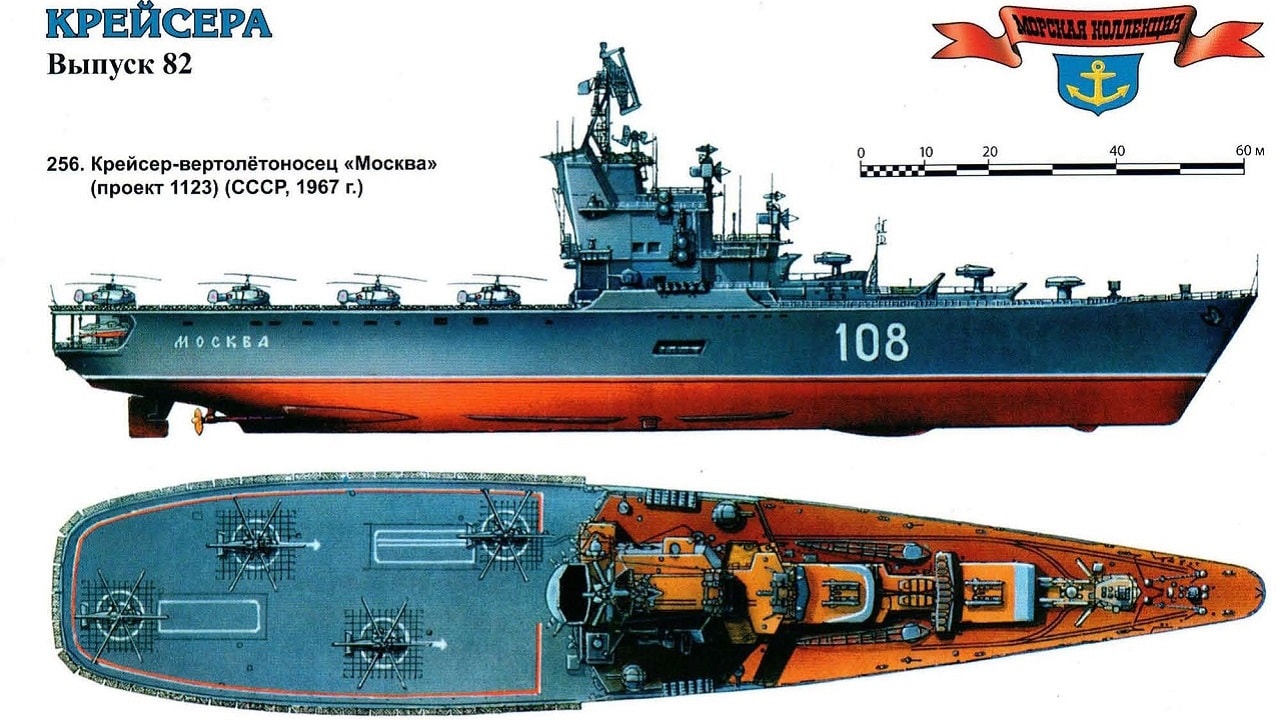The Soviet Union’s Moskva-Class Carrier-Cruisers: a Failed Experiment in Doing Everything at Once – The Soviet Navy was undoubtedly late to the aircraft carrier game. Consistent with the fact that Russia has primarily been a land power since the dawn of Russian history (including into the Soviet era), Soviet military officials were slow to adopt a costly hallmark of a modern blue-water navy, capable of engaging other fleets at stand-off distance and acting as a long arm of state interests around the world.
Such reservations translated into a bizarre mashup of different ideas in the form of the Project 1123 Kondor class of ships that would eventually come to be commonly referred to as Moskva-class helicopter carriers in the West.
Development of the Moskva Class
Lessons learned on the value of air power in naval combat and the development of American submarine-based nuclear weapons helped to drive Soviet interest in the development of aircraft carriers, or at least the capability to employ fleet-based naval aviation.
By the mid-1950s, hesitations in Moscow surrounding the value of fleet-based aviation and on the claim that carriers were characteristic tools of Western intervention and aggression had given way, and development of a light carrier began in earnest.
The Moskva, the first ship of the class that gave its name to the Western designation of the class, was laid down in 1962 or 1963 and completed in 1967, and was subsequently joined by its only other completed sister ship, the Leningrad, in 1969. A third example of the class was laid down, but was ultimately never completed.
What made a Moskva a Moskva?
For starters, modern students of Russian and Soviet naval history should be careful not to confuse the Moskva-class with the Moskva (the now famous flagship of the Russian Black Sea fleet), which was sunk by a Ukrainian missile in April 2022 as part of Russia’s February 2022 invasion of the country.
Developed to do battle with American and NATO submarines, the Soviet designers of the Moskva opted to dedicate the stern-half of the class to a deck for launching helicopters, while the bow section included a large arsenal of anti-submarine and anti-aircraft missile systems.
Onboard hydroacoustic and radar systems were intended to assist Project 1123 Kondor ships in their anti-submarine mission by launching missiles, depth charges, torpedoes and even nuclear-tipped anti-submarine missiles from a scattered variety of missile launchers and torpedo tubes. In its production version, the Moskva-class ships could carry fourteen helicopters, which were variants of the Ka-25 anti-submarine and search-and-rescue helicopters.
What Happened to the Moskva Class?
Once launched, the two completed Moskva-class helicopter carriers quickly began to seem obsolete in comparison to the American submarines they were supposed to target.
While they were initially designed with to counter American submarines which needed to operate close to shore, advances in American nuclear delivery vehicle technology allowed such submarines to operate far offshore, thereby leaving the Moskva-class out to dry. The Soviet’s Project 1123 ships were similar in configuration and design to helicopter carriers built in the same timeframe for the French and Italian navies.
However, both the Moskva and the Leningrad would not survive the collapse of the Soviet Union. The Leningrad was the first to go, being officially decommissioned and sold for scrap in 1991, while the Moskva would not meet the same fate until 1996.
Having never seen combat, it is difficult to ascertain how the two examples of the Project 1123 Kondor class of ships would have fared in a modern naval war against American submarines.
However, it is probably fair to assume that they would have been too little, too late in such a conflict, given the fact that they were nearly obsolete upon arrival.
Wesley Culp is a Research Fellow at the Center for the Study of the Presidency and Congress. He regularly writes on Russian and Eurasian leadership and national security topics and has been published in The Hill as well as in the Diplomatic Courier. He can be found on Twitter @WesleyJCulp.

